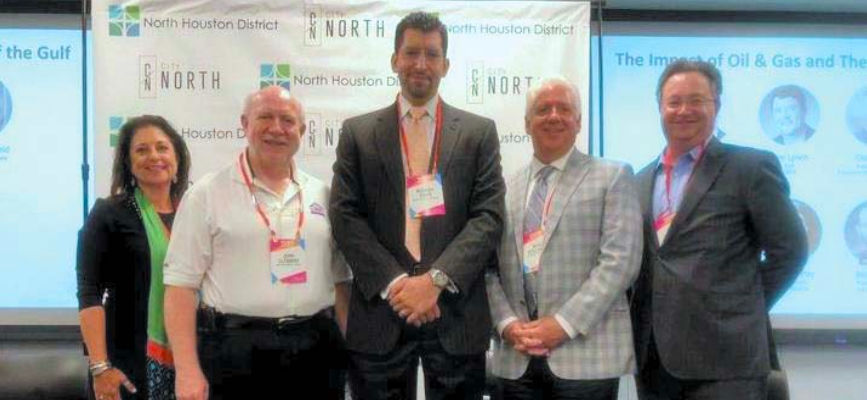

Local and new tenants join panel on relocating and growth
Approximately 150 guests gathered at the City North Conference Center for the Bisnow Commercial Real Estate Event (CRE) co-hosted by the North Houston District and Lincoln Property Company on October 4.
Bisnow, an online CRE trade publication with 17,000 subscribers in Houston, was a strategic partner in the planning of the event and hosts CRE events all over the country and internationally, focusing on topics related to the developments in key markets.
The first panel included area tenants and representatives from Emser Tile, Meridian Energy Group, Texas Children’s Center for Women and Children and Conn’s Distribution Center. From affordability, accessibility to customers and proximity to the airport, guest speakers shared their reasons for moving or expanding their businesses to the District.
“Why do business here?” Emser Tile’s vice president of real estate, Mark Comstock asked, “Because it’s easy,” referring to Houston’s license and permit process. In addition, a second panel of experts discussed the impact of oil and gas on commercial real estate.
Want to invest in industrial assest in Houston? One answer is to build near the Grand Parkway
By Tierra Smith
Unlike the office industry, the industrial sector was able to stabilize under the oil downturn due to the expansion of the petrochemical industry in Houston. It had a transformative effect, Austin Industries Vice President Russell Carter said. Fracking and other energy-related technological advances led to the decoupling of natural gas and crude oil prices, which spurred demand and expansion within the petrochemical industry and its related suppliers. “The long-term supply of natural gas in North American because of shale gas and fracking has changed the global dynamics,” he said. “Houston sits at the epicenter of what the impact is going to be.” And now, offshore drilling is making a recovery. Within the next two months, the major oil and energy companies will begin finalizing their capital budgets and determining new platforms to launch, JLL Global Energy Practice Leader Bruce Rutherford said. The first place to invest in offshore drilling is in the Gulf of Mexico, he said. Oil extracted there is filtered through the undersea pipeline network, which is connected to the world’s largest petrochemical complex, which is then connected to the largest market for refined products. The second-largest market is the North Sea, he said. JLL research indicates the offshore business will be in full bloom by the second half of 2019 and predicts a boost in real estate demand in late 2019.
Originally, Houston-based industrial developer Vigavi wanted to have a significant presence in the southeast submarket to be close to its oil and gas clients, Vigavi Development Associate Christen Hatfield said. But as the price of oil began to slip, the growth of the petrochemical companies filled the manufacturing space. For example, all of the tenants at the Fairmont Industrial Center in La Porte service chemical plants. Vigavi has four industrial parks in southeast Houston near the Houston Ship Channel. The company is paying over $7/SF for a build-to-suit development currently under contract, she said. That is a big leap from between $2 and $2.50 in the same area about eight years ago, according to Lynch. “When we thought the price of oil was going to affect our business, it actually did the opposite and brought new players into the market,” Hatfield said.
Industrial Demand Picking Up Along Grand Parkway
As space runs out in southeast Houston, developers are looking elsewhere. Industrial product is thriving along the Grand Parkway, which is expected to have a similar effect as the Beltway 8 in terms of connectivity and access for industrial end users. The toll road will connect the suburbs from Conroe, Freeport to the south, Baytown to the east and west to Katy. Hatfield, whose company operates two industrial parks in Katy, one of the fastest-growing submarkets in Houston, said Houston suburbs are ideal for industrial because of the reduced tax rate, lower cost of living and cheaper land cost. “Land is too expensive if you are anywhere close to the Beltway 8,” Lynch said. Industrial space along the Grand Parkway is picking up interest from institutional money, Lee & Associates partner Reed Vestal said. “[At first], they were kind of scared of investing in areas they seemed to think of as prairies,” Vestal, who specializes in land and industrial assets, said. “Now, I can tell you over the last six to nine months, we have seen an enormous amount of activity along the Grand Parkway

